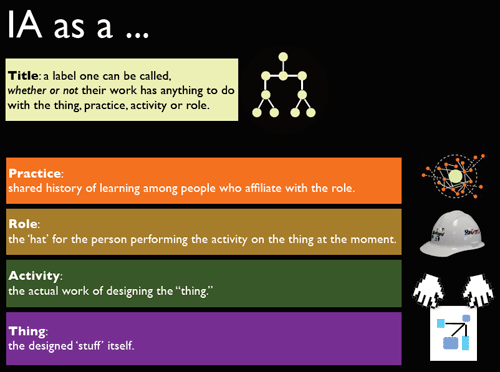In the closing talk for this year’s IA Summit, I had a slide that explains the various layers that make up what we use the term “Information Architect” (or “Information Architecture”) to denote. I think it’s important to be self-aware about it, because it helps us avoid a lot of wasted breath and miscommunication.
But I also stressed that I don’t think this model is only true of IA. So please, feel free to replace “IA” in the diagram with the name of any practice, profession or domain of work.
To understand this diagram, especially the part about Practice, it helps to have a basic understanding of what “practice” is and how it emerges from a community that coalesces around a shared concern. The Linkosophy deck gets into that, and my UX as Communities of Practice deck does as well, while getting into more detail about the participation/reification dynamic Wenger describes in his work.
Here’s the model: I’ll do a bit of explanation after the jump.
Starting from the bottom:
1. IA as a thing: the object we work on, the material we work with. We might say “hey could you look at the IA
in these wireframes and see if it makes sense?”
2. IA as an activity: the literal act of working on the ‘thing’ … “doing” IA.
3. IA as a role: the “hat” you wear that says “I’m a person working on this at the moment” … like in baseball, for a while you’re a pitcher, then later you’re a batter. These are just temporary roles used to designate what activity you’re performing.
4. IA as a practice: the shared history of learning among people who affiliate strongly with the role over time.
5. IA is sometimes a title: but titles are really different … they’re not necessarily based on the actual work you do or the practice you affiliate with; they’re arbitrary labels assigned to you by some authority.
A title is something you give yourself, or that your employer gives you. But it very often has little to do with your actual job; and it especially rarely has anything to do with the practice with which you affiliate most closely. How many restaurant waiters are really actors? Waiting tables isn’t their preferred practice, but it may be the most official title they have.
Now, the waiting tables example is an extreme, but many UX practitioners find themselves in jobs where much of their work isn’t even centered on UX … in fact, most of us put up with 50% bureaucratic junk just so we can use the other 50% doing real User Experience work, which is what truly interests us. Even within the UX family of practices, most of us wear multiple “hats” — play multiple roles — within our daily work.
Among UX practitioners, some of us gravitate more toward the IxD community and its obsessions, while some of us tend to focus more on the IA side of things, or the Usability/Evaluative sort of work. This is perfectly natural, because it’s a normal (and somewhat unavoidable) pattern of human behavior to form one’s identity in part based on a chosen practice. Etienne Wenger has said that practices are natural “homes for identities.”
We get bent out of shape and very emotional about debates around practice definition mainly because of this very human dynamic where our practice-of-choice becomes a big part of our identities.
But some perspective is in order, especially now that so many practices can’t work in ivory silos anymore — the new, accelerated culture that’s been catalyzed and enabled by the Internet demands that we get over ourselves and learn how to work with other tribes.
Tags: communities of practice, Information Architecture, profession, ux, wenger



